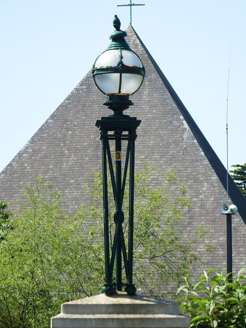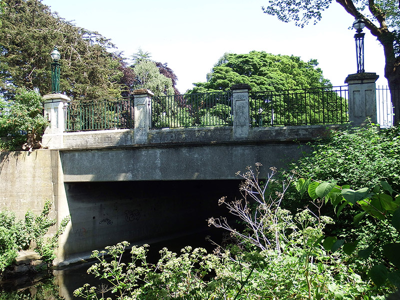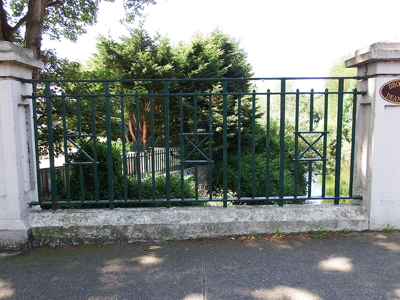Survey Data
Reg No
50130053
Rating
Regional
Categories of Special Interest
Architectural, Artistic, Technical
Original Use
Bridge
In Use As
Bridge
Date
1920 - 1940
Coordinates
315469, 237199
Date Recorded
29/05/2018
Date Updated
--/--/--
Description
Single-span concrete road bridge, built c. 1930 to carry St. Mobhi Road over Tolka River. In-situ concrete abutments and reinforced cast-concrete deck spanned by cornice. Parapet comprises square-plan painted piers with recessed panels and stepped pyramidal caps and cast-concrete plinth wall supporting painted wrought-iron railings inset with series of 'X' motifs; wider outer piers with twin panels supporting inverse-tapered cast-iron lamp standards with spherical glass lanterns set in iron framework. Painted metal signage to east with lettering 'Dean Swift Bridge' and to west having 'Droichead Dean Swift'.
Appraisal
An early twentieth-century concrete and iron bridge, most likely constructed during the development of the Glasnevin and Drumcondra suburban housing developments. The bridge is well detailed and is a good example of inter-war classicism, characterized by a geometric emphasis, with particularly fine iron lamp standards at either end. It takes its name from the original name of St. Mobhi Road, 'Dean Swift Avenue', which in turn was named after Jonathan Swift, Dean of St. Patrick's Cathedral from 1713-45, who had links to Delville House (now demolished) located northwest of the bridge. The bridge is of technical interest as a good example of engineering technology using cast concrete, carrying traffic over the Tolka River in a single span. Remaining largely intact, it is an attractive feature and contributes to the story of the development of the Glasnevin and Drumcondra suburbs.





